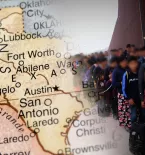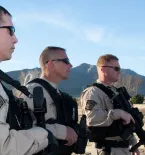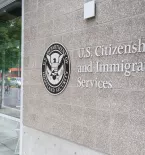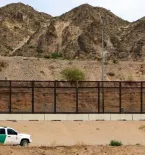
Border Security
The United States has approximately 7,500 miles of international land border; about 1,954 miles along Mexico and another 5,525 miles along Canada. In addition, the U.S. maintains over 95,000 miles of maritime border on the east and west coasts, Hawaii, Alaska, and other territories.[1]
Maintaining the security of land, sea and air borders is essential to the sovereignty of any nation. Without secure borders, illegal immigrants, criminals, gang members, terrorists and dangerous narcotics can enter and cause havoc in our communities.
The agencies that protect our borders are housed within the Department of Homeland Security. Customs and Border Protection (CBP) is the main agency responsible for securing our borders. CBP includes the U.S. Border Patrol, the Office of Field Operations and Air and Marine Operations. The Border Patrol is responsible for patrolling territory between[2] official ports of entry and 2,000 miles of coastline surrounding the Florida Peninsula and the island of Puerto Rico. The Office of Field Operations is responsible for guarding 328 official ports of entry[3] to the United States. Ports of entry may be located along our land borders or maritime borders (i.e., seaports). Other ports of entry are located in the interior of the U.S. – namely at international airports, such as JFK airport in New York City.
Border Security may be measured in several ways. One important measure of border security is the number of aliens who are caught illegally entering the United States. Pre-COVID, the agencies categorized this number in two ways. The Border Patrol would report on the number of illegal aliens “apprehended”, and the Office of Field Operations would report on the number of “inadmissible” aliens who showed up at the ports of entry. Despite the two terms, both represent the same thing: aliens who have crossed into the U.S. illegally. Then in 2020, with the onset of the COVID-19 pandemic and the implementation of the Title 42 expulsion authority, the agencies began to group apprehensions, inadmissibles, and Title 42 expulsions (which technically were not “apprehensions” or “inadmissbles” because they were not conducted under the authority of Title 8) under the umbrella term “encounters.”[4]
Another important measure of border security is how many illegal aliens have crossed the border but were able to evade capture. These are typically called “gotaways.” While it may seem counter-intuitive, Customs and Border Protection regularly calculates the number of gotaways (even if it does not publish the information). It does so by logging the number of aliens agents witness crossing into the U.S. and are unable to capture for various reasons (such as distance or insufficient agents or vehicles on hand). Drone footage or radar may also supply CBP with additional numbers of gotaways.
Border security may also be measured by the arrests of alien smugglers, the quantity of illegal drugs seized, the number of vehicle incursions along the border, and other violence at the border such as assaults on U.S. border agents. The exploding fentanyl crisis, for example, has demonstrated how Mexican drug cartels have exploited weaknesses in recent border policies that dedicate border agents to processing and releasing illegal aliens instead of patrolling the borders. Cartels then use the absence of agents as an opportunity to bring in fentanyl and other drugs without resistance.
Finally, border security may be measured by our effectiveness in screening aliens who enter the U.S., legally and illegally. For example, the number of suspected terrorists apprehended illegally entering the U.S. between the ports of entry has grown from 2 in FY 2017 to 172 in FY 2023.
Government agencies typically report border security statistics by month and fiscal year. For the federal government, the fiscal year (FY) runs from October of one year through September of the following year. For example, Fiscal Year 2023 began on October 1, 2022, and ended September 30, 2023.
- Between 2021 and 2023, the number of migrants who had illegally entered the U.S. stood at over 8 million people. This is almost equivalent to the entire population of Virginia or New York City, or over six times the number of active service personnel in the U.S. armed forces.
- In FY 2023, the number of encounters stood at 3.2 million and there were at least 1.8 million known “gotaways” who evaded capture by CBP.
- In FY 2022, CBP encountered over 2.7 million illegal aliens at America’s borders and there were 600,000 known gotaways.[5]
- In FY 2021, CBP had over 1.6 million encounters nationwide, a figure that was more than quadruple the figure from the previous year, and there were 389,155 known gotaways.[6]
- It is not just the southern border that is under siege. The northern border has also seen surges in illegal immigration.[7] In FY 2023, encounters at the Swanton Sector, which borders Canada, were 6.5 times higher than in FY 2022.
- In August 2022, an Ipsos poll found that more than half of Americans believe that the US is experiencing an invasion at the Southwest border and nearly three-quarters believe the scale of migrants apprehended at the border is a problem.[8]
- The first attempt at a border wall/fence was in 1993, when the Clinton administration erected a “primary fence” in California. Subsequent pushes to extend the wall following surges in alien crossings in the early 2000s led to the Secure Fence Act of 2006, which authorized the construction of a partial border fence along the U.S.-Mexico border. Despite bipartisan promises, Americans had to wait over a decade to see construction on the border wall begin. The Trump administration built or replaced 452 miles of the border wall, but the construction halted with the end of Donald Trump’s presidency.
- Migrants and smugglers often flee law enforcement in high-speed chases known as “bailouts.” They are now so common in some border communities that barriers are built to prevent crashes and deaths. Law enforcement believes bailouts are increasing due to a perception by smugglers that CBP is overrun and will be less likely to catch them if they flee.
- In FY23, CBP seized over 27,000 pounds of fentanyl, a huge increase from the 14,700 pounds confiscated in FY22 and far surpassing the 11,200 pounds confiscated in FY21.
- Since 2020, 97 percent of fentanyl and nearly 90 percent of heroin were intercepted by CBP at the southwest border.[9] Over 100,000 Americans per year die of opioid overdoses.[10]
- In FY 2023 CBP intercepted 140,000 pounds of methamphetamine, over 81,000 pounds of cocaine and 150,000 pounds of marijuana.[11]
- In FY 2022, there were over 4,000 offenders convicted of smuggling aliens, accounting for 24.2% of all immigration offenders sentenced. In 10.9% of alien smuggling cases, an unaccompanied minor was being smuggled.[12]
- Cartels charge up to $15,000 to smuggle migrants across the border.[13] Migrants are often forced to wear wristbands showing cartel affiliation and whether they have paid their smuggler. After successfully entering the U.S., many migrants are exploited and abused by cartel members that force them to work in dangerous low-paying jobs, perform sex work or pay protection money.
- In 2021, the cartels made around $13 billion from their human trafficking and smuggling businesses.[14]
- In FY22 and FY23 combined, nearly 291,000 children were encountered at the border unaccompanied, many of whom are exploited by cartels or traffickers. According to an Inspector General report in early 2023, Health and Human Services and Homeland Security lost track of over 85,000 UACs in just two years after being unable to contact them in follow-up calls, leading to concerns that they may have been trafficked.
The failure of government to secure our borders undermines the public’s trust in our institutions and the rule of law. Robust laws that are fully enforced are critical to securing our borders. The flow of illegal aliens, cartel members and drugs can be blamed on the failure of successive administrations to secure the border.
FAIR supports numerous measures to secure our borders, including finishing building a wall or fence along the U.S. border with Mexico – where the vast majority of illegal aliens attempt to enter. In addition to technology and barriers, FAIR also supports an increase in personnel, such as Border Patrol agents, to monitor, detect, apprehend and detain people who cross illegally or overstay their visa. Finally, securing the border requires the government to impose consequences for illegal entry, as already required by federal law. This means the swift detention and removal of those who break the law.
To download the PDF of this page click here.
Endnotes
[1] www.dhs.gov/news/2022/12/29/today-dhs-will
[2] https://www.cbp.gov/border-security/along-us-borders/overview
[3] https://help.cbp.gov/s/?language=en_US
[4] https://www.dhs.gov/ohss/about-data/glossary
[5] https://www.cbp.gov/newsroom/stats/cbp-enforcement-statistics
[6] Ibid
[7] https://www.cbp.gov/newsroom/local-media-release/border-patrol-s-swanton-sector-apprehensions-encounters-reach-historic
[8] https://www.ipsos.com/en-us/news-polls/npr-immigration-perceptions-august-2022
[9] https://www.cbp.gov/newsroom/stats/drug-seizure-statistics
[10]https://www.cdc.gov/drugoverdose/deaths/index.html.
[11] https://www.cbp.gov/newsroom/stats/drug-seizure-statistics
[12] https://www.ussc.gov/sites/default/files/pdf/research-and-publications/quick-facts/Alien_Smuggling_FY22.pdf
[13] https://www.newsweek.com/human-smugglers-charging-15000-per-person-us-border-crossing-1597043
[14] https://homeland.house.gov/2023/07/19/chairman-green-every-dollar-the-cartels-rake-in-comes-at-the-cost-of-an-american-life-or-livelihood.

























